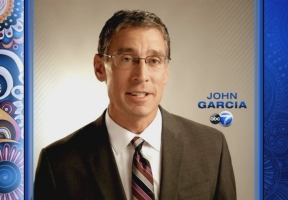By: Ashmar Mandou
 ABC 7 Chicago reporter John Garcia is a fixture in the media landscape with a career spanning over 30 years. Committed to telling the stories of Chicagoans in the most accurate and compelling ways, Garcia a Chicago-native, has managed to navigate the evolution of journalism while inspiring the next generation of Latino journalists to follow suit. Beginning his career in Sioux City, Iowa in 1986, then moving onto ABC 7 in San Antonio where he co-anchored the morning and noon newscasts, Garcia joined ABC 7 Chicago in 1994 and along the way received numerous awards for his work, including five Regional Emmys and an Illinois Broadcasters’ Association Silver Dome Award. On his down time, Garcia serves on the board for the Juvenile Diabetes Research Foundation and is a member of the Chicago Association of Hispanic Journalists and the National Association of Hispanic Journalists. As we close out our Hispanic Heritage Month series, we place a spotlight on Garcia where he shared advice for the next wave of Latino journalists.
ABC 7 Chicago reporter John Garcia is a fixture in the media landscape with a career spanning over 30 years. Committed to telling the stories of Chicagoans in the most accurate and compelling ways, Garcia a Chicago-native, has managed to navigate the evolution of journalism while inspiring the next generation of Latino journalists to follow suit. Beginning his career in Sioux City, Iowa in 1986, then moving onto ABC 7 in San Antonio where he co-anchored the morning and noon newscasts, Garcia joined ABC 7 Chicago in 1994 and along the way received numerous awards for his work, including five Regional Emmys and an Illinois Broadcasters’ Association Silver Dome Award. On his down time, Garcia serves on the board for the Juvenile Diabetes Research Foundation and is a member of the Chicago Association of Hispanic Journalists and the National Association of Hispanic Journalists. As we close out our Hispanic Heritage Month series, we place a spotlight on Garcia where he shared advice for the next wave of Latino journalists.
Lawndale News: I am always curious to learn about the origin story of a fellow journalist. Can you tell me what chain of events led you to a career in journalism?
John Garcia: In high school, I was on the school newspaper. My mother, actually was a newspaper editor for our paper. When I went to college, I was interested in theater as well. So I kind of always had that personality of being on camera, I guess. My strengths were not in math, they were more in writing, so that’s kind of what it came down to. In college it seemed like journalism was what I was best at, so it worked out that way, I guess. [Laughs]
LN: You joined ABC 7 Chicago in 1994 and since then the journalism ecosystem has tremendously changed. How were you able to navigate such a complex, ever changing landscape to ensure your voice, your stories remained heard?
JG: Good question. It has evolved quite a bit long before I even came to Chicago. My first job was in Iowa and I was shooting, and editing, and writing and doing all of that myself. I was a one-person operation. It was on a format of videotape that we haven’t used for many, many years [laughs]. Now we don’t even use tapes, it’s all electronic carts. But I think, you know, the real answer is that although there are a lot of technological change, but I still remember my very first job in Sioux City. The chief photographer there talking about how all cameras do the same thing it’s just that the buttons are in different places. That’s kind of the same thing about storytelling, about reporting. You’re just telling somebody’s story. How you gather that may be a different way, but you are really going out and talking to people, finding out what’s important about different stories, and hopefully telling their stories in an accurate way.
LN: According to the National Association of Hispanic Journalists, there is an increase of Latinos entering the media profession. As a high-profile journalist do you feel a sense of responsibility to inspire a younger generation of Latinos in the journalism field?
JG: Oh, absolutely. I feel a sense of responsibility for that and I feel a sense of responsibility to the community, as well to represent as much as possible and as well as possible and to share stories from the community. I’ve always felt a big responsibility, certainly in the role that I have at NAHJ.
LN: What advice do you have for aspiring journalists who want to follow in your footsteps?
JG: I think curiosity is really important, obviously as a journalist because you want to learn as much as possible about what you’re writing about and if you have an interest in telling people’s stories. The most important thing you can do in journalism is to listen and remember that the story is not about you, it’s not about me, you are telling someone else’s story. You are being given the privilege of telling someone else’s story.
Photo Credit: ABC 7 Chicago









